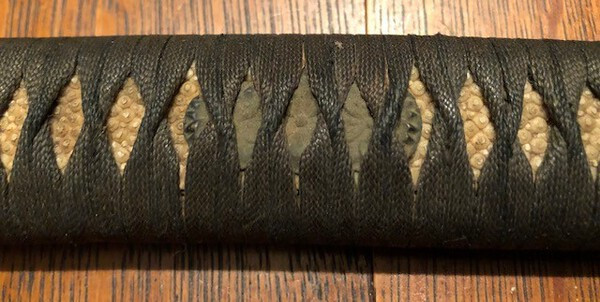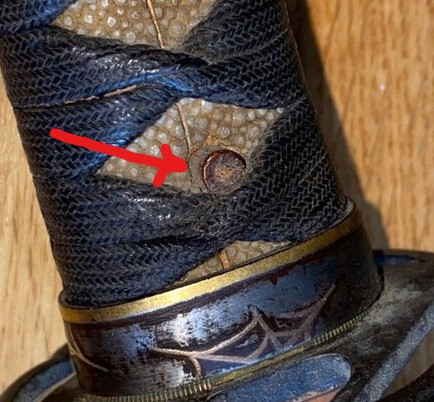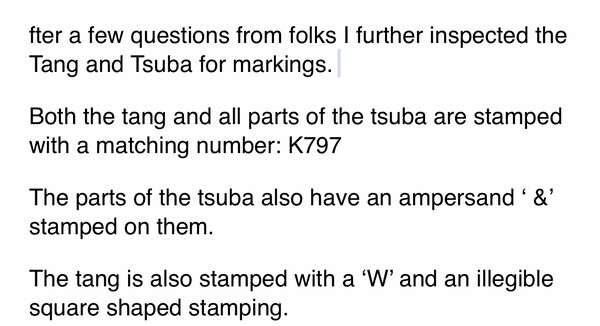-
Posts
13,108 -
Joined
-
Last visited
-
Days Won
157
Content Type
Profiles
Forums
Events
Store
Downloads
Gallery
Posts posted by Bruce Pennington
-
-
These kind of swords are always controversial. The problem is that there is no documentation to verify their source. Another problem is that the lower quality workmanship of the occupied lands is so similar to the workmanship of Chinese fakes that it is almost impossible to tell them apart.
We do know for a fact that swords were made in occupied lands. And I think there are some telltale signs one can go by. For example, the alternating direction of the wrapping, and the quality of the metal fittings. Both are typical Japanese and not normally found on fakes.
I believe many of our top experts on nihonto have very little experience studying World War II gunto and almost no experience studying late war and occupied land swords. It is just not their area of expertise.
-
 3
3
-
-
Ok, I see now the seller was simply referencing Fuller's discussion of swords made in the field and by collaborating forces.
-
 1
1
-
-
Wow! Did you buy this from Richar Fuller?! Same maker for sure. I didn't post the kabutogane of Yoshimichi's, but they are the same


The fuchi and leather cover snaps are also the same.
Interesting that all 3 have different tsuba.
-
From Sesko's book:
NORISADA (則貞), Shōwa (昭和, 1926-1989), Gifu – “Norisada” (則貞), real name Katō Sumitarō (加藤隅太郎), he worked as guntō smith
-
Agree with Brian, that without seeing the nakago, or greater detail of the blade, ID is impossible. John, @PNSSHOGUN, ran a thread on long swords, where several were discussed:
-
Hello Jonathan, and welcome! I'm down in Colorado Springs, and would love to see that sword personally some day. Life is crazy-busy for the near future, but when it settles down, I'd love to get up there to meet you and see the sword.
Can you post pics of the full rig and closeups of various parts like the tsuka, tsuba, and a couple of blade shots including the tip?
I have 3 others like this on file. No one has been able to translate the mark. That, combined with the late-war style fittings, point toward an island-made sword for the local forces teamed up with the Japanese, or for the Japanese themselves. Many thousand troops were essentially stranded with no reinforcements and no re-supply until the end of the war. There were some local smithing being done in some of the occupied lands, Java being the most famous, and these swords could be from one of those places.
Of course they also could be from a Chinese fake operation, but in this case, I don't think they are.
Here's one from @Stegel




and from @Yoshimichi




-
Mathieu,
This peg holds the handle to the blade.

The end you see is likely the fatter end, so it must be tapped/pushed out from the other side. The other side is hidden under the wrap, so simply push gently under the wrap to tap it out
The handle and handguard should easily slide off the blade at that point. Sometimes they are stuck with grime and/or a little rust. Don't let that bother you. Simply wiggle the handguard and/or tap it some, and everything will eventually break loose.
-
 5
5
-
-
Not a "marine" sword. No official title to this model, but it was an attempt to simplify the Type 98. Called many things by collectors - Type 44; Marine landing sword; Type 3; Type 100; Rinji Seishiki; Contengency model. Designed in 1938 off a variation loophole to the Type 98 Imperial Order, introduced in 1940, and sort of finally got popular in 1943/44. Definitely Army, though, not Navy (or Marine).
-
 1
1
-
-
Behind a wall........
Lucky find Glenn!
-
Well, @IJASWORDS, there's a potential Shop logo to find in your book! - "&"
Feeling 90% sure this is a shop stamp, as it is on the seppa/tsuba, this adds to the evidence that shops stamped blade nakago, with logo at least, as well as used painted numbers. The most famous is the Suya Shoten operation. But, I feel stongly (75%) that the stamped numbers on nakago are almost always done by the Army (Navy evidence is too scarce to say), so the numbers on this blade COULD be done by the Army, while the added "&" behind the number simply means the fittings shop used the Army number, plus logo, as the assembly number in their shop. But that's just my current theory.
-
@Swords - how about a shot of that ‘&’ stamp too! Looks like we have 2 of them now.
-
22 hours ago, Kiipu said:
As I linked to above, the wartime zōhei-tō 造兵刀 came about via the Type 95. Mass production began in earnest in 1943 and more zōhei-tō were made late in the war than Type 95s. The Japanese army needed officer's swords and they needed lots of them. Hence the development of the zōhei-tō. It took the best features of the Type 95 and ported it over to the requirements of an officer's sword.
A noobie question - Murata-to began in the late 1800's. Did they simply not take off in production? Were the zoheito derived from Murata's blade ideas or are the 2 completely unrelated to each other?
-
I track and file numbered blades, could you post a photo of that number on the nakago, please?
-
Incredible. Everyday our country devolves deeper into a 3rd world country. My wife's parents grew up in Ecuador. They would wait in line to pay their bills, rather than mail payment in, because postal workers would steal the money out of the envelopes.
Sorry to hear about your swords being stolen.
-
 2
2
-
 1
1
-
-
-
17 hours ago, blackpowder said:
What do you think about how old it can be?
There are some guys on this forum that may address that, but you'll find a lot more of them at the Nihonto Forum of NMB. They'll need a full length shot of the bare blade, good close-ups of the blade tip and mid-section, showing hamon (temper line) and steel texture, and good shots of the nakago. Measurements help too:
-
 1
1
-
-
18 hours ago, BANGBANGSAN said:
Thanks Trystan. So, it is a discussion posted by someone about the registration process. He gave an example, posted above, but it's not necessarily a quote from the regulation. But if accurate/complete, it's still a bit of evidence to add to the ongoing debate.
-
Wow! The stuff did what it was designed to do, I guess!
-
Well. After reviewing several nakago of Type 95s and Zoheito, I'd have to lean toward John's zoheito idea too. While the blades and blade tips are almost identical, the T95 nakago are longer, narrower, and lack a fully discernable yakote. This one has the same shape and look of other zoheito nakago I have on file.
Steve, if this were an officer sword made with a Type 95 NCO blade, it would be a rare one to have in hand, as actual ones are very rare to come by. If it's a zoheito, then it's not all that rare. Less common than standard Type 94/98 gunto, but there are plenty of them around the collecting world.
Zoheito were an attempt to mass produce blades for officers during the sword shortage years after switching from the western styled kyugunto over to the samurai styled Japanese swords. Single piece of steel, not made the traditional way. The look and feel is almost identical to the Type 95 blade.
On a side note: Do any of our zoheito experts know if the factories churning out zoheito were completely separate from the Type 95 ones? Seems to me the only difference is the shape of the nakago. Could they have been from the same specs, or from the same factories?
-
 1
1
-
-
-
-
4 hours ago, BANGBANGSAN said:
prefectural board of education.
Trystan, where did you find this discussion? Whomever made the policy believes the Showa and Anchor stamps indicate showato. Interesting they left out the Seki stamp.
-
The W or M is a midway inspection mark. It seems to be tied to the Tokyo First Arsenal. And if there is a star on that blade, could I get photos of both sides of the nakago, please?
-
From those photos, I would say it is a Type Chinese Fake.
i’ve never seen a scabbard lock squared off like that. And the artwork on both end caps is off. The blade looks possibly better than the normal fake, but I would have to see more of it to say.
-
 3
3
-






WW2 Japanese sword Marking
in Military Swords of Japan
Posted
An update. For anyone filing/tracking these, it turns out Jonathan's sword is the same sword posted earlier by @Yoshimichi. Don't know why the tsuba was swapped for another, but the nakago, and saya marks are identical.
Edit: Disregard the mention of tsuba. I had mind-melded the sword from Stegel into this, which has a different tsuba. I checked my files and don't have a shot of the Yoshimichi tsuba. It's likely the same one.